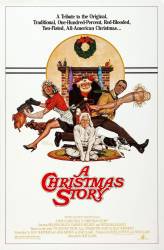Trivia: The director realised last minute while reviewing the movie for theatrical release that he did not ask permission from Disney to show Mickey Mouse in the film. He immediately contacted Disney, showed them the footage, and offered to cut it out as their very low budget did not allow for compensation to them. Disney gave permission to use it without compensation. According to the director: "They were pretty sweet with us about it. It was good publicity for them."

A Christmas Story (1983)
1 trivia entry since 3 Mar '25, 20:53
Directed by: Bob Clark
Starring: Darren McGavin, Melinda Dillon, Peter Billingsley, Scott Schwartz
Other mistake: When Ralphie and Flick are walking to school for the first time, they meet up with Schwartz, coming down the steps of his house which appears to be two houses down from Ralphie's. Later, when Ralphie is lying in bed after the soap in the mouth scene, the narrator (older Ralphie), states how "Three blocks away, Schwartz was getting his."
Question: Why do the parents have two twin beds in their bedroom, instead of one double bed? I thought that was just a TV gimmick from the old days when they weren't allowed to show a man and woman in bed together. Did people really sleep like that, or was it just a production design decision for the film? The movie was made in the '80's after all.
Chosen answer: Many married couples did (and still do) sleep like this. For example, one may be a restless sleeper and not wish to disturb their partner. Or they may just prefer to sleep alone. It's all down to personal choice, I don't think there's a rule that says couples have to share a bed.
Answer: Very common, especially back in the first half of the 20th century, for couples to sleep in separate beds.
Join the mailing list
Separate from membership, this is to get updates about mistakes in recent releases. Addresses are not passed on to any third party, and are used solely for direct communication from this site. You can unsubscribe at any time.
Check out the mistake & trivia books, on Kindle and in paperback.




Answer: It's most likely a reference to the twin-bed movie standards from the time in which the movie takes place (late '30s to early '40s).